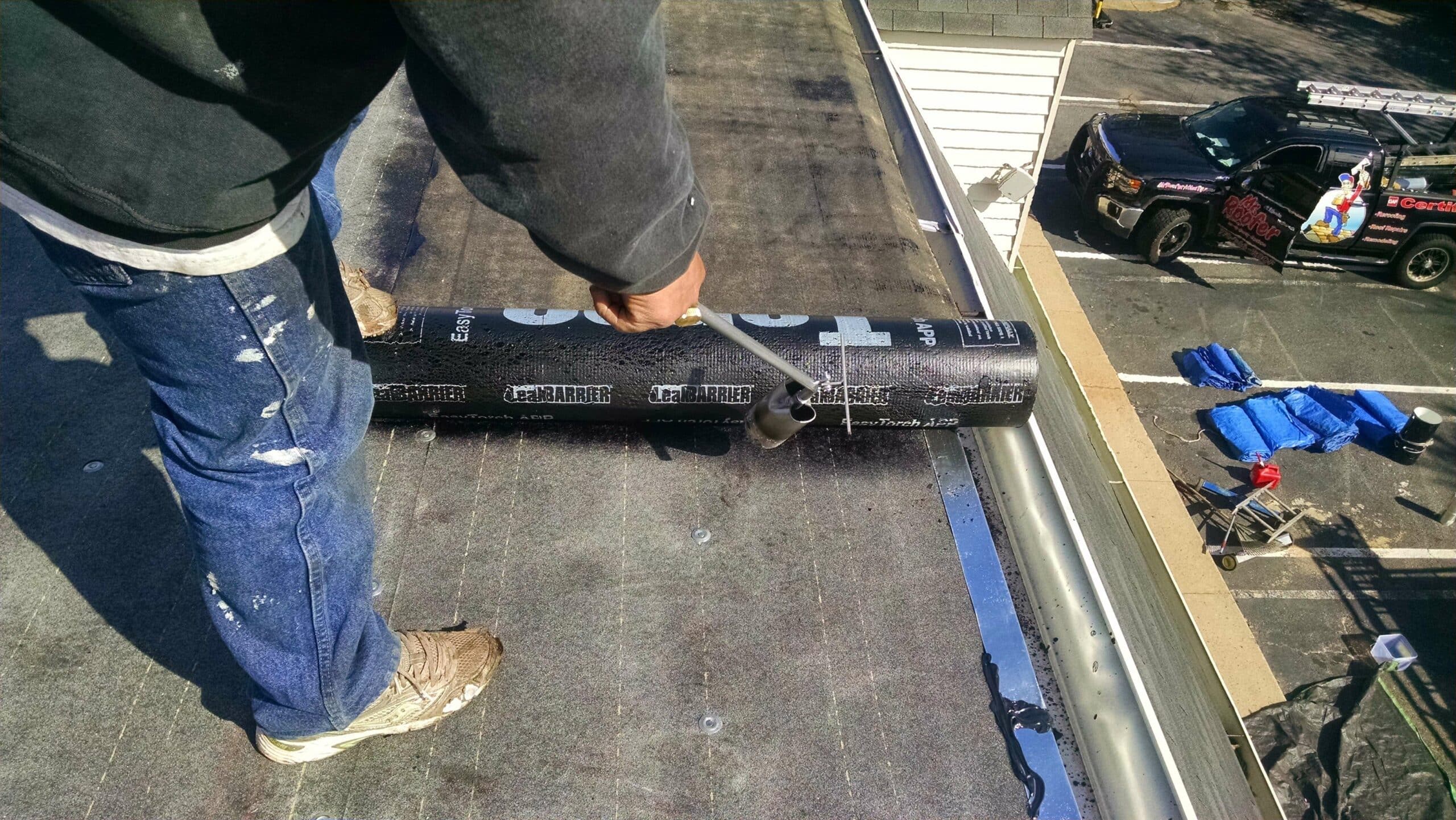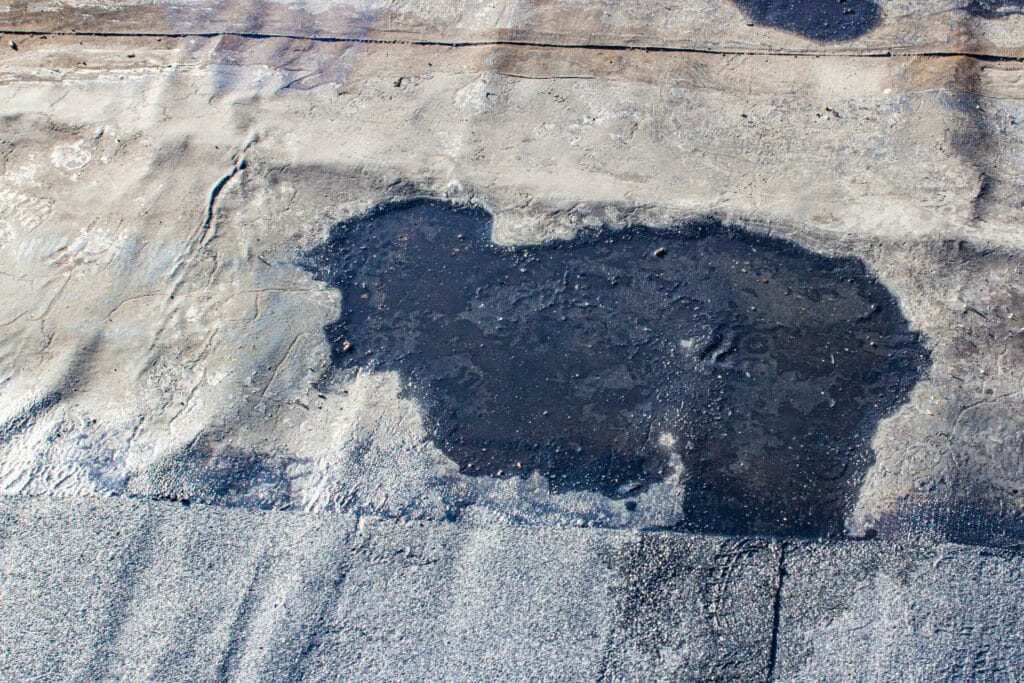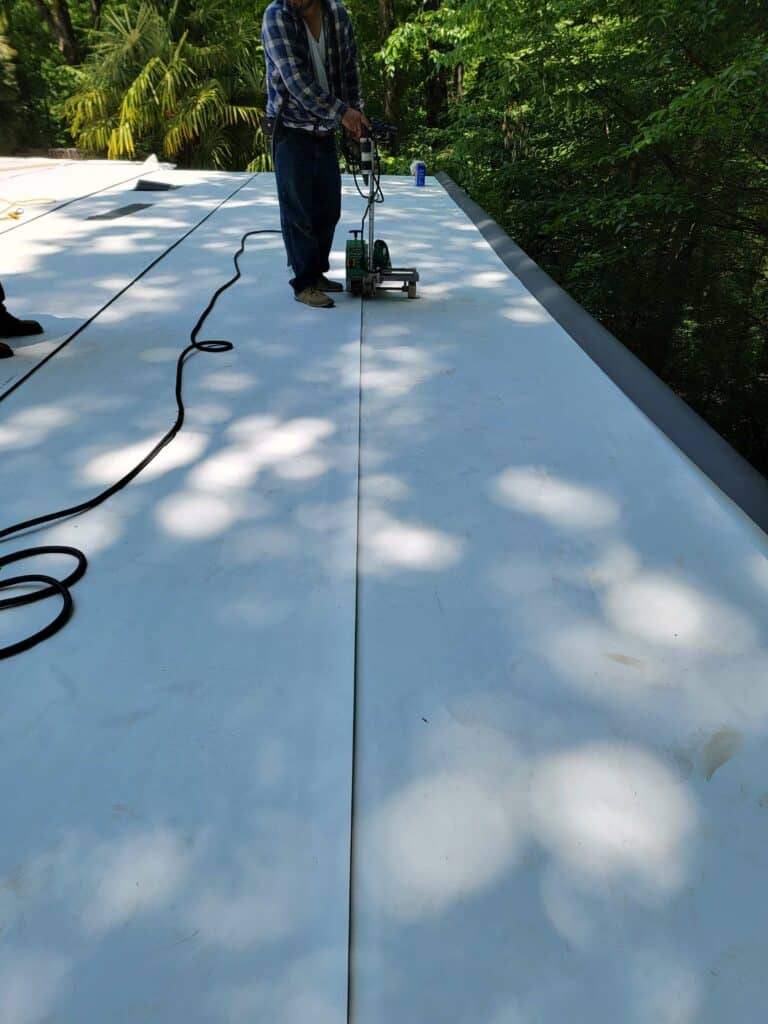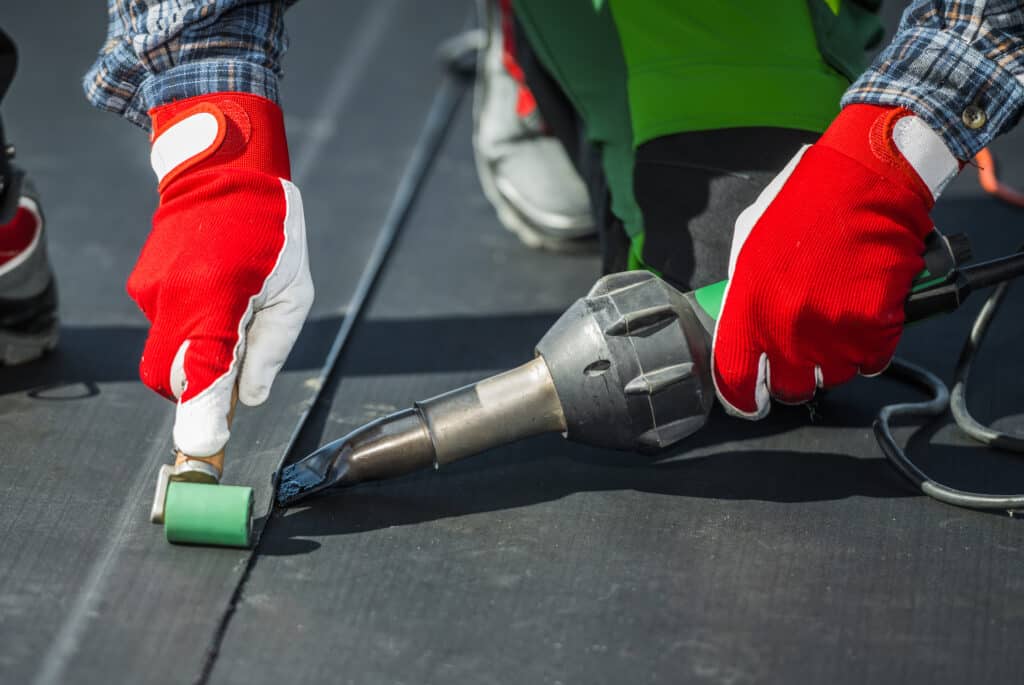
Every time it rains in Atlanta, you glance nervously at your flat roof, wondering if the next downpour will leave water stains on your ceiling or puddles forming on your deck. Maybe you’ve noticed small leaks, blistering, or that your energy bills keep climbing despite running the air conditioner nonstop. Flat roofs may look simple from the ground, but they hide complex layers of membrane, insulation, and drainage that need careful attention.
For homeowners in Atlanta, ignoring these signs can turn minor issues into costly repairs. That’s where Mr Roofer comes in. With years of experience replacing and repairing flat roofs across the city, their team understands exactly how Georgia’s intense sun, sudden storms, and humid climate affect TPO, EPDM, and modified bitumen systems. We don’t just replace flat roofs: we provide solutions that combine durability, energy efficiency, and peace of mind.
Whether your roof is showing visible damage, losing its insulating power, or simply reaching the end of its lifespan, Mr Roofer offers expert guidance, high-quality materials, and certified installation that protects your home and your wallet. With Mr Roofer, Atlanta homeowners can finally stop worrying about leaks and start enjoying a safe, comfortable home all year round.
Common Signs You Need to Replace a Flat Roof

Flat roofs rarely fail all at once. Instead, they show clear warning signs long before major leaks or structural issues appear. Knowing what to look for helps you catch problems early, protect your home, and avoid the higher costs that come with waiting too long.
Visible Damage and Leaks
When a flat roof starts to fail, the earliest clues often show up inside your home. Water stains on ceilings, peeling paint, mold growth, or a musty odor all point to moisture intrusion. If you notice sagging surfaces or dark patches around vents or walls, water may be pooling on the roof deck or finding its way through seams.
One of the most critical red flags is ponding water that remains for more than 48 hours after rainfall. Because flat roofs rely on precise drainage, prolonged ponding indicates an underlying slope, structural, or membrane problem. Over time, that standing water accelerates membrane wear, weakens seams, and invites leaks.
Mr Roofer’s technicians frequently trace leak sources back to failing pipe boots, cracked or improperly sealed flashing, lifted seams, and punctures near rooftop equipment. These small components play an outsized role in a flat roof’s watertight performance, and when they deteriorate, moisture quickly finds a way in.
Aging and Material Wear
Even the best residential flat roofing systems have a finite lifespan. Most TPO, EPDM, and modified bitumen roofs last between 15 and 25 years, but Georgia’s intense UV exposure shortens that timeline. High temperatures, humidity, and sudden weather shifts accelerate membrane aging.
As a roof approaches the end of its service life, homeowners may notice:
- Cracking
- Surface brittleness
- Blistering
- Delamination
These symptoms occur when heat breaks down adhesives, UV rays weaken the membrane surface, and moisture becomes trapped between layers. Once these failures begin, repairs offer only temporary relief because the underlying material is no longer structurally reliable.
Rising Energy Bills and Insulation Failure
Older flat roofs often lack modern ISO board insulation or contain insulation that has become compacted or moisture-logged over time. When insulation stops performing, your home becomes harder to cool in Atlanta’s long summers and more difficult to keep warm during cold snaps.
If you’ve noticed rising energy bills or inconsistent indoor temperatures, your flat roof may be losing efficiency. Upgrading to a new system with high R-value ISO board and reflective TPO or durable EPDM can significantly:
- Reduce heat gain
- Stabilize interior comfort
- Lower long-term utility costs
This improvement is one of the most overlooked benefits of replacing an aging flat roof, and it has a measurable impact on overall home performance.
Evaluating Flat Roofing Materials for Replacement

Choosing the right material is one of the most important decisions a homeowner can make during a flat roofing replacement project. Each system has unique strengths, performance characteristics, and ideal applications. A proper evaluation ensures long-term protection, energy efficiency, and durability tailored to your home’s needs.
Roofing Material | What It Is | Key Benefits | Lifespan | Best Uses | Notes from Mr Roofer |
TPO (Thermoplastic Polyolefin) | Single-ply membrane with heat-welded seams | Highly reflective for hot climates, energy efficient, lightweight, strong welded seams | 20-30 years | Most residential flat roofs needing energy savings and modern performance | Recommended for Atlanta homeowners seeking efficiency, lower cooling costs, and a clean, modern system |
EPDM (Ethylene Propylene Diene Monomer) | Rubber-based single-ply membrane | Extremely durable, UV-resistant, flexible in temperature swings, easy to repair | 30+ years | Home additions, garages, low-slope homes, and areas needing long-term reliability | Excellent for homeowners wanting a low-maintenance, long-lasting rubber roof |
Modified Bitumen (SBS or APP) | Asphalt membrane enhanced with polymer modifiers, installed in two layers | High durability, strong waterproofing, handles foot traffic, versatile installation options | 20-25 years | Walk-out roofs, balconies, and roofs with regular access | Ideal for homes needing rugged strength with modern waterproofing |
ISO Board (Polyisocyanurate insulation) | High-R-value insulation board used under membrane systems | Boosts energy efficiency, improves drainage with tapered systems, prevents condensation | N/A (insulation layer, not a membrane) | Paired with TPO or EPDM for maximum thermal performance | Critical for modern flat roofing; reduces heat gain and stabilizes indoor comfort |
PVC Roofing | Single-ply membrane similar to TPO but with enhanced chemical resistance | Strong seams, heat-weldable, highly durable, chemical resistant | 20-30 years | Homes near restaurants, workshops, or chemical exposure | Great option where grease or chemical runoff is possible |
Built-Up Roof (BUR) | Multi-layer tar and gravel system | Strong, time-tested, good puncture resistance | 20-30 years | Older homes with existing BUR systems | Heavy and less energy-efficient; often replaced with modern membranes |
TPO Roofing: Energy-Efficient and Affordable
Thermoplastic Polyolefin, commonly known as TPO, is one of the most popular residential flat roofing materials because of its balance of cost, efficiency, and modern performance. Its white reflective surface helps reduce heat absorption, making it ideal for hot climates like Atlanta, where cooling costs can rise quickly. The membrane features heat-welded seams that create a continuous, watertight bond and outperform traditional adhesives.
TPO is lightweight, allowing it to work well on homes with low load-bearing capacity. With proper installation and routine care, a TPO system can last 20 to 30 years. While maintenance needs are minimal, the quality of seam welding is critical, which is why certified installation is essential. Mr Roofer often recommends TPO to Atlanta homeowners looking for an affordable, energy-efficient, and long-lasting upgrade that performs exceptionally well in intense sunlight.
EPDM Roofing: Durable and Cost-Effective
Ethylene Propylene Diene Monomer, or EPDM, is a synthetic rubber membrane known for its remarkable durability and longevity. Often referred to simply as rubber roofing, EPDM is highly resistant to UV rays and temperature swings, making it one of the longest-lasting flat roofing materials on the market. Many properly installed EPDM roofs exceed 30 years of service.
EPDM can be installed fully adhered or mechanically fastened, allowing flexibility in matching your home’s structure and slope. Its repairability is another advantage, as small punctures or tears can be easily patched. This system excels in:
- Residential additions
- Detached garages
- Low-slope homes
- Any property that needs a tough membrane with a proven track record
Modified Bitumen: Classic Strength Meets Modern Technology
Modified bitumen combines traditional asphalt with polymer modifiers such as SBS or APP to create a membrane that is stronger, more flexible, and more resistant to aging than older built-up systems. These roofs offer dual-layer protection with a base sheet and cap sheet, giving homeowners an added level of durability and redundancy.
Because modified bitumen can withstand foot traffic, it is ideal for walk-out roofs, balconies, or areas where occasional maintenance access is required. Installation methods include heat welding, cold adhesives, or self-adhering sheets, giving contractors flexibility based on project needs and home safety considerations. For homeowners seeking time-tested reliability paired with enhanced waterproofing, modified bitumen remains a standout option.
ISO Board: The Unsung Hero of Energy Efficiency
Polyisocyanurate insulation, commonly known as ISO board, is the foundation of most high-performing flat roof systems. It increases the roof’s R-value, helping reduce heat transfer and improving energy efficiency throughout the home. ISO board can also be used to create a tapered slope, improving drainage and reducing ponding water issues that often lead to leaks.
Modern TPO and EPDM roofing systems frequently require ISO board as part of their installation to meet energy codes and ensure proper performance. When paired with a reflective membrane like TPO, ISO board forms a powerful combination that keeps homes cooler during Atlanta’s long, hot summers and stabilizes indoor comfort year-round.
Other Residential Flat Roof Options
In addition to TPO, EPDM, and modified bitumen, homeowners have several other flat roofing choices. Each option has unique benefits and applications:
- PVC Roofing: Similar in appearance to TPO, PVC offers superior chemical and grease resistance, making it ideal for homes near workshops, restaurants, or areas exposed to harsh substances. It is highly durable, heat-weldable, and energy-efficient when paired with reflective membranes.
- Built-Up Roof (BUR): The classic tar and gravel system used on many older homes. BUR provides multiple layers of protection and excellent puncture resistance. While heavy and less energy-efficient than modern membranes, it remains a reliable choice in certain applications.
- Spray Polyurethane Foam (SPF): A seamless, spray-applied roofing system that expands to fill gaps and create a watertight surface. SPF provides excellent insulation, reduces energy costs, and conforms to irregular roof shapes, but requires professional installation and regular maintenance coatings.
- PVC/Modified PVC Hybrids: Some homes benefit from hybrid membranes combining PVC or modified bitumen layers for extra durability, chemical resistance, or UV protection. These are ideal for roofs with rooftop equipment or higher exposure to environmental stressors.
Mr Roofer carefully evaluates each system based on the home’s slope, structure, and budget to recommend the most reliable, energy-efficient, and cost-effective solution for flat roof replacement.
Cost to Replace a Flat Roof

Replacing a flat roof is a major investment, and costs vary widely depending on material selection, roof structure, existing damage, and local market conditions. Understanding the factors that influence pricing helps homeowners make informed decisions and budget appropriately. In Atlanta, where weather extremes, intense sun, and heavy rainfall can accelerate roof wear, investing in the right materials and installation quality is crucial for long-term performance.
Average Flat Roof Replacement Cost Overview
Roofing System | Estimated Cost per Square Foot | Average Total Cost for a 1,000 sq ft Flat Roof | Notes |
TPO | 7 to 12 per sq ft | 7,000 to 12,000 | Energy efficient and cost effective with welded seams |
EPDM | 6 to 11 per sq ft | 6,000 to 11,000 | Long-lasting rubber membrane with excellent durability |
Modified Bitumen | 8 to 14 per sq ft | 8,000 to 14,000 | Dual-layer protection and strong waterproofing |
PVC | 8 to 15 per sq ft | 8,000 to 15,000 | Highly durable with superior chemical resistance |
Built-Up Roof (BUR) | 9 to 16 per sq ft | 9,000 to 16,000 | Heavy multi-layer system often replaced with modern membranes |
ISO Board Insulation Add-On | Additional 2 to 5 per sq ft | Adds 2,000 to 5,000 | Increases R-value and improves drainage in tapered systems |
These estimates provide a baseline for homeowners, but actual costs may fluctuate depending on factors such as tear-off complexity, structural repairs, and additional features like rooftop equipment or skylights. Choosing high-quality membranes from manufacturers like GAF Liberty or CertainTeed Flintlastic may increase material costs slightly, but provides superior longevity and warranty protection.
Factors That Influence Flat Roof Replacement Costs
Flat roof replacement involves far more than just installing a new membrane. Multiple variables influence the total cost, and understanding these factors helps homeowners make informed decisions, avoid surprises, and maximize long-term value.
Roof Condition and Moisture Damage
The current condition of your roof is one of the most significant cost drivers. Flat roofs are particularly susceptible to ponding water, which can lead to saturated insulation, rot, and structural deterioration over time. Moisture damage may not be visible from the exterior, so a thorough inspection is essential.
- Deck Replacement: If water has compromised the structural deck beneath the membrane, replacement or reinforcement may be necessary. This adds labor, material, and disposal costs.
- Insulation Replacement: Wet or deteriorated insulation, such as ISO board or fiberglass, must be removed and replaced to restore thermal performance.
- Mold Treatment: Moisture intrusion can lead to mold growth, which requires professional remediation to ensure the safety and health of your household.
By addressing these issues during replacement, homeowners prevent recurring leaks, structural damage, and long-term maintenance costs.
Complexity of the Roof Layout
Flat roofs vary in complexity, and features such as multiple levels, parapet walls, green roofs, or rooftop decks add labor, materials, and time. Each additional element increases installation difficulty:
- Multiple Levels: Roofs with staggered heights or split-level designs require extra flashing, membrane cutting, and precise drainage planning.
- Parapets: Walls along the roof edge need properly integrated flashing and coping to prevent leaks, adding both labor and material costs.
- Green Roofs: Living roof systems require specialized underlayment, drainage layers, and irrigation considerations. Removing an existing green roof adds demolition costs.
- Rooftop Decks: Flat roofs with decks require membrane protection for foot traffic, special drainage detailing, and sometimes protective coatings, increasing installation complexity.
Complex roofs also require more precise planning, experienced crews, and sometimes equipment like cranes or scaffolding, all of which influence total costs.
Choice of Material and Insulation
Each flat roofing replacement material carries its own price range. TPO is generally the most cost-effective for energy efficiency, while EPDM offers longevity at a moderate price. Modified bitumen and PVC tend to cost more but deliver excellent waterproofing and durability. Insulation choices such as high R-value ISO board or tapered systems also influence the total project investment.
Local Labor and Permitting in Metro Atlanta
Flat roof replacements in Atlanta are subject to local building codes, energy standards, and permitting requirements. Costs may include permit fees, inspections, and compliance-related upgrades.
- Building Permits: Most flat roof replacements require permits to ensure the work meets structural and safety standards. Fees vary by project size and complexity.
- Energy Code Compliance: New roofing systems may need to meet Atlanta’s energy efficiency regulations, such as minimum R-values or reflective membrane requirements.
- Inspection Requirements: Some municipalities require inspections during or after installation to verify compliance with building and fire codes.
Working with certified professionals like Mr Roofer ensures that every permit, inspection, and code requirement is handled efficiently, reducing the risk of fines or failed inspections while ensuring the roof meets local standards.
Additional Cost Considerations
- Material Selection: Membrane type (TPO, EPDM, modified bitumen, PVC) and insulation choices significantly impact costs. High-quality brands like GAF Liberty or CertainTeed Flintlastic may increase upfront costs but provide better long-term performance and warranty coverage.
- Labor Rates: Experienced installers command higher rates, but their expertise ensures proper seam welding, flashing installation, and overall system longevity.
- Tear-Off and Disposal: Removing old roofing material safely adds labor and disposal fees, especially for multi-layer or heavy systems like BUR or modified bitumen.
By understanding these factors, homeowners can budget realistically and choose solutions that protect their home while maximizing performance and lifespan.
Why Investing in Quality Installation Pays Off
A flat roof’s performance depends on precise installation. Even top-quality membranes fail if seams are not welded correctly, flashing is poorly cut, or insulation is improperly installed. Quality installation prevents moisture infiltration, mold growth, blistering, and early membrane degradation, saving homeowners costly repairs later.
Cheap Materials or Poor Workmanship Cause Leaks, Mold, and Premature Failure
Cutting corners with low-quality materials or inexperienced labor often results in leaks, trapped moisture, and mold growth beneath the membrane. Over time, the roof deteriorates faster, requiring more frequent repairs or full replacement. These issues also compromise the home’s structural integrity and energy efficiency.
Mr Roofer’s Certified Plus Installers Ensure Durability and Warranty Protection
Mr Roofer’s Certified Plus team follows manufacturer-approved methods for every flat roof installation, including top-rated systems from GAF Liberty and CertainTeed Flintlastic. Our installers are trained to handle each brand’s specific requirements, from precise seam welding and flashing installation to proper ISO board placement and moisture inspections.
This attention to detail ensures every layer performs as intended, maximizing the lifespan of your flat roof while maintaining the integrity of the manufacturer’s warranty. For Atlanta homeowners, that means long-lasting protection, consistent performance, and peace of mind knowing your roof has been installed to the highest professional standards with trusted materials.
Common Mistakes to Avoid During Flat Roof Replacement

Flat roof replacement is a major investment, and even small mistakes can compromise performance, lead to leaks, or reduce the lifespan of your roof. Homeowners who understand these pitfalls can make smarter choices, avoid costly repairs, and ensure their investment delivers long-term protection and energy efficiency.
1. Using Substandard Materials
Selecting low-quality membranes, adhesives, or insulation may seem like a way to save money upfront, but it almost always leads to premature failure. Inferior TPO, EPDM, or modified bitumen can crack, shrink, or delaminate under heat, UV exposure, and thermal expansion. Over time, this deterioration allows water infiltration, leading to deck damage, mold growth, and structural issues. Poor-quality materials also void manufacturer warranties, leaving homeowners exposed to financial risk if leaks or defects occur.
Some membranes fail due to inadequate thickness, improper reinforcement, or low-quality polymer blends. This can reduce tensile strength and elongation, making them more susceptible to wind uplift, ponding water, and UV degradation.
To avoid this, always choose high-quality membranes from trusted brands like GAF Liberty or CertainTeed Flintlastic, which are engineered for durability in hot, humid climates like Atlanta. Pair them with ISO board insulation to improve thermal performance and extend the roof’s service life.
2. Hiring Unlicensed or Inexperienced Installers
Flat roof installation requires specialized skills, including precise seam welding, flashing placement, correct membrane adhesion, and proper insulation integration. Inexperienced contractors may cut corners, rush installations, or fail to follow manufacturer specifications, leading to leaks, blistering, or insulation gaps. Many of these issues are not immediately visible, but they can manifest as major water damage within months or a few years.
Incorrect seam welding or mechanical fastening, improper flashing around parapets and penetrations, and failure to account for roof expansion can all compromise membrane integrity.
Instead, hire certified installers, such as Mr Roofer’s Certified Plus team, trained in manufacturer-approved installation methods. Their expertise ensures every layer, from insulation to membrane, is installed correctly, maximizing longevity and warranty compliance.
3. Ignoring Insulation or Drainage Issues
Flat roofs are especially vulnerable to ponding water, condensation, and heat gain if insulation and drainage aren’t addressed. Over time, poor drainage accelerates membrane wear, causes leaks, and damages the roof deck. Insufficient insulation leads to energy loss, higher utility bills, and uncomfortable indoor temperatures.
Tapered ISO board can improve drainage and prevent ponding. Properly designed insulation systems reduce thermal bridging, prevent condensation, and increase membrane performance under heat stress.
You can counter this by incorporating ISO board insulation and tapered slopes during replacement. This not only prevents water accumulation and deck damage but also improves energy efficiency, lowering monthly heating and cooling costs.
4. Skipping Proper Tear-Off and Deck Inspection
Replacing a flat roof without removing the existing membrane and inspecting the decking is a common mistake. Hidden moisture, rot, or structural weaknesses can compromise the new roof, causing premature membrane failure, leaks, and voided warranties.
Flat roof decks, particularly plywood or OSB, can deteriorate under long-term ponding or prior leaks. Installing a new membrane over compromised decking can trap moisture, leading to accelerated rot and structural degradation.
Instead, ensure the tear-off process is thorough. Remove debris, inspect for moisture damage, and repair or reinforce the deck before installing the new roofing system. This ensures a solid foundation for membrane adhesion and long-term performance.
5. Overlooking Roof Penetrations and Flashing
Skylights, vents, chimneys, and HVAC units are common leak points. Incorrectly flashed penetrations allow water to bypass even the best membrane, creating hidden damage that worsens over time.
Flashing must integrate seamlessly with the membrane and slope to direct water away from vulnerable areas. Improper flashing or adhesive use can lead to blistering, seam failure, and leaks around penetrations.
Ensure all penetrations are properly flashed and sealed using manufacturer-recommended materials and techniques. Certified installers follow precise protocols to prevent leaks and protect warranty coverage.
6. Cutting Corners on Maintenance Access and Safety
Flat roofs require periodic inspections to remove debris, clear drains, and monitor membrane integrity. Neglecting safe access or inspection planning can make maintenance difficult, dangerous, and less effective.
Walk pads, designated paths, and accessible drains prevent damage during maintenance. Without these, homeowners risk puncturing membranes or creating unsafe conditions for inspectors or contractors.
Instead, plan for safe access points and inspection paths during installation. This ensures future maintenance can be conducted safely, efficiently, and without damaging the roof membrane.
7. Failing to Plan for Long-Term Performance and Warranty Compliance
Some homeowners focus solely on upfront costs and overlook warranty and long-term performance requirements. Poor installation, incorrect materials, or skipped inspections can void warranties, leaving the homeowner fully responsible for repairs.
Manufacturer warranties often require strict adherence to installation protocols, including membrane type, seam welding, insulation, flashing, and drainage.
Partner with certified contractors like Mr Roofer, who use approved materials and follow manufacturer protocols to maintain warranty protection and maximize the lifespan of your roof.
By avoiding these mistakes, homeowners protect their investment, extend the lifespan of their flat roof, and reduce the risk of costly repairs. Partnering with an experienced, certified contractor like Mr Roofer ensures proper material selection, precise installation, and long-term performance, keeping your home safe, comfortable, and energy-efficient.
Conclusion
Replacing a flat roof is a major decision, but understanding the signs of wear, the best materials, and the factors that influence cost makes the process far less overwhelming. From energy-efficient TPO and long-lasting EPDM to classic modified bitumen and the insulating power of ISO board, each option offers unique benefits tailored to your home’s needs. By choosing quality materials and professional installation, you protect your investment, improve energy efficiency, and ensure peace of mind for years to come.
When it comes to flat roof replacement in Atlanta, Mr Roofer combines technical expertise, certified installation, and personalized guidance to deliver durable, high-performing roofs. Don’t wait until leaks or damage force costly repairs. Contact Mr Roofer today for a professional assessment and expert flat roof replacement that keeps your home safe, comfortable, and protected.
